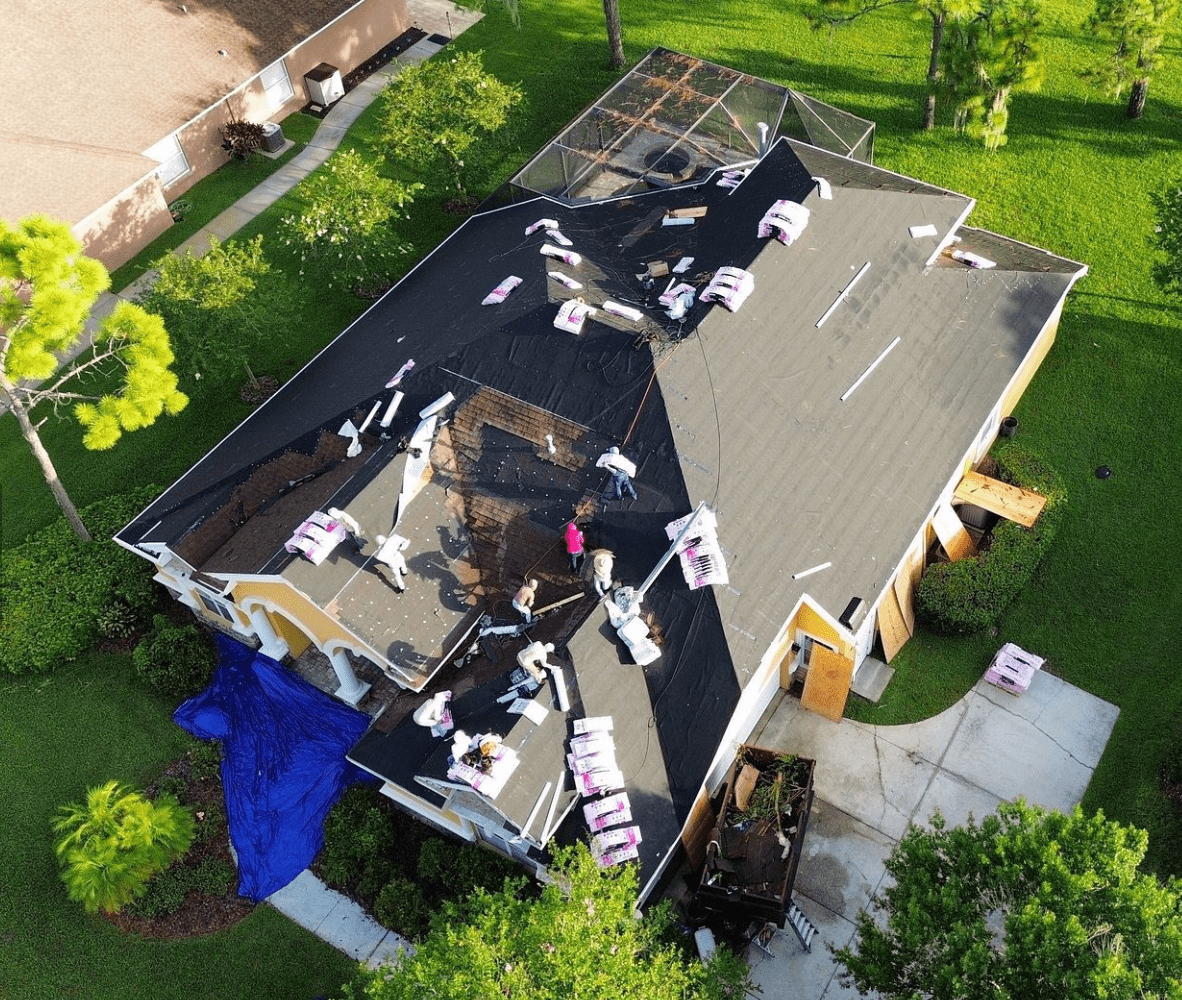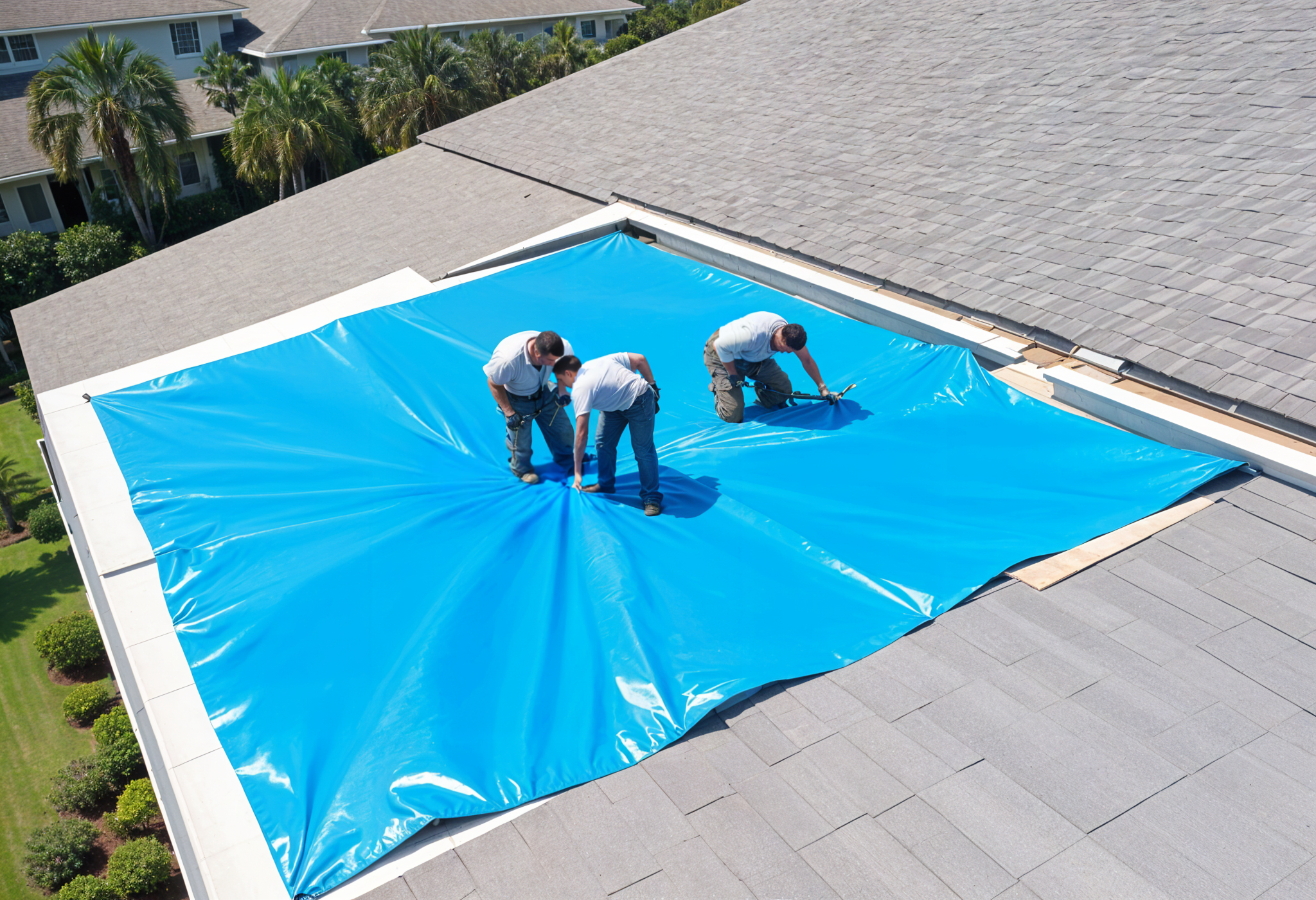Introduction: What Is Roof Tarping?
Roof tarping is the process of covering a damaged or leaking roof with a heavy-duty waterproof tarp to protect the building until permanent repairs can be made. Whether it’s storm damage, a roof leak, or missing shingles, a roof tarp acts as a temporary shield against water, debris, and weather elements.
Roof tarping is not just for homes. It’s commonly used for residential and commercial buildings alike—especially after hurricanes, hailstorms, heavy rain, or fire damage.
Why Roof Tarping Is Important
When your roof is damaged, even a small delay in action can lead to bigger problems like:
- Water leaking into ceilings and walls
- Mold growth inside the house
- Electrical hazards
- Structural damage
Tarping your roof provides instant protection, giving you time to plan for full repairs without letting the damage get worse.
When Do You Need a Roof Tarp?
You should consider roof tarping in these situations:
- Storm Damage
After a hurricane, windstorm, or hail, parts of your roof may be exposed. A blue tarp for roof coverage is ideal in these situations.
- Roof Leaks
If you notice water stains on ceilings or walls, it could be a leak. Tarping prevents more water from entering.
- Fire Damage
After a fire, parts of your roof may be missing or weakened. A roof tarp helps keep out the elements.
During Roof Replacement or Repairs
Roofers often use tarps during ongoing work to protect the inside of the building.
What Is a Roof Tarp Made Of?
Most roof tarps are made from polyethylene (poly) material that is waterproof, UV-resistant, and tear-resistant. The most common type is the blue tarp for roof protection because it is:
- Easy to spot from a distance
- Durable in various weather conditions
- Affordable and available in many sizes
Other tarp colors like silver or white are also used depending on the situation and need for UV reflection.
How Roof Tarping Works (Step-by-Step)
Here’s how professionals usually install a roof tarp:
- Roof Inspection
The damage is assessed to find all weak spots.
- Measurement & Tarp Selection
A tarp large enough to cover the damage is selected—usually a roof tarp that extends 3-4 feet past the damaged area.
- Debris Removal
Loose shingles or branches are cleared off.
- Tarp Placement
The tarp is carefully spread over the damaged section.
- Securing the Tarp
It is secured with wood strips, nails, or screws. In some cases, sandbags or weights are used to hold it down.
Edge Sealing
The edges are sealed or tucked to prevent water from blowing underneath.
How Long Can a Roof Tarp Last?
While a roof tarp is a temporary fix, high-quality tarps can last up to 90 days with proper installation. However, it’s recommended to get permanent roof repairs done as soon as possible.
Benefits of Roof Tarping for Homes & Businesses
| Benefit | Description |
| Immediate Protection | Shields the interior from rain, debris, and pests |
| Cost-Effective | Prevents costly water damage and mold issues |
| Insurance Compliance | Most insurers require tarping to prevent further loss |
| Safety | Keeps the building safe from collapse or electrical issues |
| Flexibility | Works for both small roof leaks and large commercial buildings |
Roof Tarping for Commercial Buildings
Commercial roofs are often flat or low-slope, which can collect water easily. In these cases, professionals may use larger tarps and weighted systems to keep them in place. Tarping protects:
- Offices
- Warehouses
- Schools
- Retail buildings
It’s essential to act quickly after a storm to reduce operational downtime and protect assets.
Cost of Roof Tarping
The price of roof tarping depends on:
- Size of the damaged area
- Type of building (residential vs commercial)
- Height and slope of the roof
- Emergency response time
Typical cost range: $200 to $1,500
Emergency commercial tarping may cost more due to equipment and labor.
Insurance may cover tarping as part of your storm or roof damage claim.
Can I Use a Roof Tarp Myself?
Yes, but with caution. DIY tarping is possible for small areas on low-sloped or accessible roofs. However, climbing on a damaged or wet roof is risky. Hiring a professional ensures:
- Safety
- Secure installation
- No further damage to the roof structure
If you’re unsure, call a local roof tarp service provider to inspect and tarp the area safely.
Blue Tarp for Roof: Why It’s So Popular
The blue tarp for roof coverage is used by professionals and emergency responders (like FEMA) because:
- It’s highly visible for safety and insurance teams
- Made from strong polyethylene material
- Available in various sizes to fit any roof
- Affordable and easy to store in emergencies
Keeping one in your emergency kit, especially during storm seasons, is a smart move.
Final Thoughts
Roof tarping is a fast, effective way to protect your home or business from further damage after a storm, leak, or fire. Whether it’s a small leak in your house or major damage to a commercial building, using a roof tarp—especially a blue tarp for roof—can buy you the time you need to plan permanent repairs.
Always prioritize safety, and don’t hesitate to call a professional if needed. A properly installed roof tarp can save you thousands in repair costs and protect what matters most.
Frequently Asked Questions (FAQ)
- How quickly should I tarp a roof after damage?
Ideally, within 24–48 hours to prevent further water damage or mold. - Can I leave a roof tarp on for a long time?
Most tarps can last up to 90 days, but it’s best to schedule repairs as soon as possible. - What’s the difference between a blue tarp and other tarp colors?
Blue tarps are most common due to visibility, availability, and cost-effectiveness. Silver tarps are often thicker and reflect heat better. - Will insurance cover roof tarping?
Many homeowner and commercial policies include tarp installation under emergency protection. Check with your insurance provider.
5. Is roof tarping only for storm damage?
No. Roof tarping can be used for leaks, fire damage, ongoing repairs, or any situation that exposes the roof’s underlayer.




